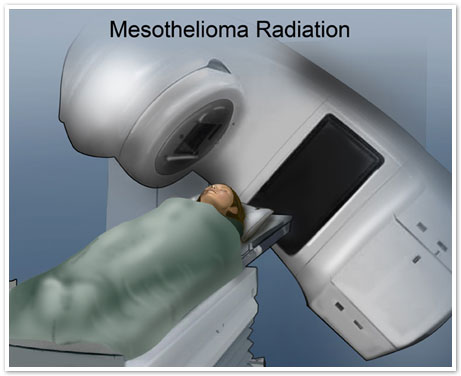For mesothelioma patients, radiation may be used after surgery to help prevent cancer growth and recurrence. It may also be employed palliatively to relieve some of the symptoms of mesothelioma and make the patient more comfortable.
Radiation therapy has been used for decades to treat cancers of all kinds. Over the years, doctors and researchers have refined their techniques to improve effectiveness while reducing damage to healthy tissue and side effects.
How Radiation Treats Mesothelioma
Radiation therapy works by damaging the DNA in mesothelioma cancer cells so that they cannot replicate and cause tumors to grow. While radiation can negatively affect healthy tissue, it is targeted so that only the parts of the body where the cancer exists are affected.
Radiation will not eradicate mesothelioma on its own. However, it can be effective in helping to manage symptoms and preventing the growth and spreading of mesothelioma to other areas of the body. With this in mind, radiation therapy is used in three primary ways.
Types of Mesothelioma Radiation Therapy
There are two types of radiation techniques used to treat mesothelioma. Each of these has its own benefits and disadvantages.
External Beam Radiation
The oldest and most widely used form of radiation therapy is known as external beam radiation. This is the form of radiation treatment most people are familiar with.
External beam radiation targets a specific locale to stop or slow the growth of malignant cells. It is administered by a machine that uses an external source to deliver radiation directly to the affected area of the body. This particular kind of treatment is painless and can be completed at an outpatient facility.
During treatment, the patient will lie flat on a table and parts of the body that should not be exposed to radiation will be shielded. A technician will be in another room controlling the radiation machine and will communicate with the patient through an intercom. The machine will make clicking, whirring, and other noises as it operates.
Generally, external beam mesothelioma radiation is administered multiples times per week for several weeks. The radiation dosage and length of therapy will depend on various factors, including the type of mesothelioma, tumor size, the overall health of the patient, and which other treatments they have undergone.
Brachytherapy
Brachytherapy (internal radiation therapy) delivers high doses of radiation directly to the tumor inside the body. This is a newer treatment that is being studied in number of different kinds of cancer, including mesothelioma.
Brachytherapy involves the implantation of tiny radioactive seeds or rods in or near the tumor. This allows highly-concentrated doses of radiation to reach the tumors, while minimizing the effect on healthy tissue. There are two types of brachytherapy.
- Permanent - Radioactive seeds are never removed, though they usually stop emitting radiation after a period of 3 to 12 months, depending on the dosage and type of radioactive material used in the treatment.
- Temporary - Radioactive seeds are implanted for a predesignated, usually short period of time, such as several weeks or months, then they are removed. The length of time depends on the goals of the radiation and the dosage.
Brachytherapy is typically delivered as an outpatient procedure and generally does not require a hospital. The radioactive material is implanted by through a metal tube or catheter. If the therapy is temporary, the applicator may be left in place until the seeds are removed.
Brachytherapy patients are advised to avoid interaction with pregnant women and small children, who are most prone to the effects of radiation. However, the amount of radiation released by a person who has undergone brachytherapy is fairly minimal.
Side Effects of Mesothelioma Radiation
Radiation treatment itself is painless, but it can cause effects on the body after it is delivered. The most common side effects of mesothelioma radiation include fatigue, skin problems, dry mouth, and oral cavity inflammation.
Severe Fatigue – Radiation saps the energy of many patients, who often report high levels of fatigue during and after the treatment. This fatigue can remain for months or even years after treatments are over.
Skin Problems – Redness, dryness, peeling, and darkening of the skin, similar to sun exposure, are common. Burning of the skin is less likely than it used to be, but it can still occur to some degree.
Mouth Problems – Radiation treatment also commonly causes extreme dry mouth or inflammation of the oral cavity. It can also cause changes in taste. These adverse effects should be reported to the patient’s doctor immediately if they are interfere with eating.





